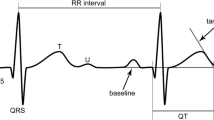Summary
The lowest mean electrical energy delivered by a D. C. defibrillator, which could induce ventricular tachycardia was determined in 20 dogs and found to be 132 W/sec. In the same animals, immediately afterwards, acute digitalization was carried out with acetylstrophanthidine and the mean electrical energy required to induce ventricular tachycardia was found to be 76 W/sec. Following acute b-adrenergic blockade with intravenous administration of Trasicor, the electrical energy had to be markedly increased (mean 230 W/sec) in order to induce ventricular tachycardia. On the contrary, acute digitalization during b-adrenergic blockade decreased the incidence of arrhythmiae instead of increasing it. (Maximal electrical energy of 400 W/sec could not induce ventricular tachycardia in all animals). This paradoxical effect of digitalization may be related to a possible b-adrenergic receptor blocking action of acetylstrophanthidine. -B-adrenergic blocking agents were also found to protect the animals as well as the patients from developing post-counter shock ventricular arrhythmiae.
Similar content being viewed by others
References
Gilbert, R., and P. Cuddy: Digitalis intoxication following conversion to sinus rhythm. Circulation 32 58–64 (1965).
Killip, T.: Synchronized DC shock for arrhythmias. J. amer. med. Ass. 186, 1–9 (1963).
Kleiger, R., and B. Lown: Cardioversion and digitalis II. Clinical studies. Circulation 36, 878–887 (1966).
Lown, B., R. Kleiger, and J. Williams: Cardioversion and digitalis drugs: Changed threshold to electric shock in digitalized animals. Circulat. Res. 17, 519–532 (1965).
Méndez, C., J. Aceves, and R. Méndez: Anti-adrenergic action of digitalis on the refractory period of the A-V transmission system. J. Pharmacol. exp. Ther. 131 199–210 (1961).
Nadeau, R. A., and T. N. James: Antagonistic effects on the sinus node of acetylstrophanthidin and adrenergic stimulation. Circulat. Res. 13, 388–398 (1963).
Robbins, W., W., Likoff and L. S. Dreifus: Complications and limitations of direct current countershock. J. amer. med. Ass. 190, 417–428 (1964).
Ten Eick, R. E., S. R. Wyte, S. M. Ross, and B. F. Hoffmann: Postcountershock arrhythmias in untreated and digitalized dogs. Circulat. Res. 21, 375–390 (1967).
Author information
Authors and Affiliations
Rights and permissions
About this article
Cite this article
Georgopoulos, A.J., Karapistolis, H. & Tountas, C. Effects of digitalization and beta-adrenergic blockade on arrhythmias induced by the direct current defibrillator. Pharmacol. Clin. 1, 119–122 (1969). https://doi.org/10.1007/BF00404657
Received:
Issue Date:
DOI: https://doi.org/10.1007/BF00404657




